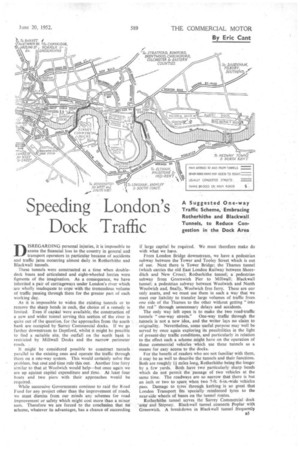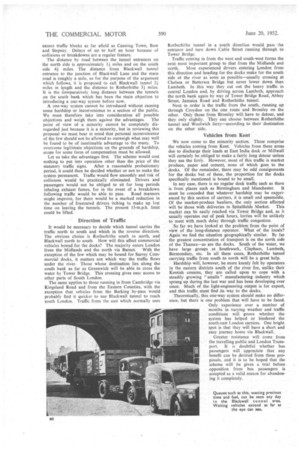Speeding London's Dock Traffic
Page 39

Page 40

If you've noticed an error in this article please click here to report it so we can fix it.
DISREGARDING personal injuries, it is impossible to assess the financial loss to the country in general and transport operators in particular because of accidents and traffic jams occurring almost daily in Rotherhithe and Blackwall tunnels.
These tunnels were constructed at a time when doubledeck buses and articulated and eight-wheeled lorries were figments of the imagination. As a conSequence, we have inherited a pair of carriageways under London's river which are wholly inadequate to cope with. the tremendous volume of traffic passing through them for the greater part of each working day.
As it is. impossible to widen the existing tunnels or to remove the sharp bends in each, the choice of a remedy is limited. Even if capital were available, the construction of a new and wider tunnel serving this section of the river is quite out of the question, for the approaches from the south bank are occupied by Surrey Commercial docks. If we 'go farther downstream to Deptford, whilst it might be possible to find a suitable site, the outfall on the north bank is restricted by Millwall Docks and the narrow perimeter roads. , It might be considered possible to construct tunnels parallel to the existing ones and operate the traffic through them on a one-way system. This would certainly solve the problem, hut cost and time rule this out. Another free ferry similar to that at Woolwich would help—but once again we are up against capital expenditure and lime. At least four boats and two piers with their approaches would be required..
While successive Governments continue to raid the Road Fund for any project other than the improvement of roads, we must dismiss from our minds any schemes for road improvement or safety which might cost more than a minor sum. Therefore we are forced to the conclusion that no scheme, whatever its advantages, has a chance of succeeding if large capital be required.We must therefore make do with what we have.
From London Bridge downstream, we have a pedestrian subway between the Tower and Tooley Street which is out of use. Next there is Tower Bridge; the Thames tunnel (which carries the old East London Railway between Shoreditch and New Cross); Rotherhithe tunnel; a' pedestrian subway from Greenwich Pier to Millwall; Blackwall tunnel; a pedestrian subway between Woolwich and North Woolwich and, finally, Woolwich free ferry. These are our only assets, and we must use them in such a way that we meet our liability to transfer large volumes of traffic from one side of the Thames to the other without getting "into the red." through unnecessary delays and accidents.
The only way left open is to make the two road-traffic
tunnels "one-way streets?' One-way traffic through the tunnels is not a new idea, and the writer lays no claim to• originality. Nevertheless, some useful purpose may well be served by once again exploring its possibilities in the light of present-day traffic conditions, and particularly in relation to the effect such a scheme might have on the operation of those commercial vehicles which use these tunnels as a means' for easy access to the docks.
For the benefit of readers who arc not familiar with them, it may be as well to describe the tunnels and their functions. Both are roughly 11 miles long, Rotherhithe being the longer • by a few yards. Both have two' particularly sharp bends which do not' permit 'the' passage of two vehicles at the same time. The roadways are so narrow that there is but an inch or two to spare. when two 7-ft. 6-in.-wide -vehicles ' pass. Damage to tyres through kerbing is so great that London Transport fits specially .reinforced tyres to the near-side wheels of buses on the tunnel routes..
Rotherhithe tunnel serves the Surrey Commercial dock 'area' and•Stipney. Blackwall tunnel connects Poplar with Greenwich. A breakdown' in Blackwall tunnel ffequently aS causes traffic blocks as far afield as Canning Town, Bow and Stepney. Delays • of up to half an hour because of collisions or breakdowns are a regular feature, The distance by road between the tunnel entrances on the north side is approximately 11 miles and on the south side zti miles. The distance from Blackwall tunnel entrance to the junction of Blackwall Lane and the main road is roughly a mile, so for the purpose of the argument which follows, it is proposed to call Blackwall tunnel 21. miles in length and the distance to Rotherhithe 3i miles. It is the Comparatively long distance between the tunnels on the south bank which has been the main objection to introducing a one-way system before now.
A one-way system cannot be introduced without causing some hardship or inconvenience to a section of the public. We must therefore take into consideration all possible objections and weigh them against the advantages. The point of view of a minority cannot be completely disregarded just because it is a minority, but in reviewing this proposal we must bear in mind that personal inconvenience of the few should not be allowed to outweigh what may well be found to be of inestimable advantage to the many. To overcome legitimate objections on the grounds of hardship, scope for some form of compensation must be allowed.
Let us take the advantages first. The scheme would cost nothing to put into operation other than the price of the statutory traffic signs. After a reasonable probationary period, it could then be decided whether or not to make the system permanent Traffic would flow smoothly and risk of collisions would be practically eliminated. Drivers and passengers would not be obliged to sit for long periods inhaling exhaust fumes, for in the event of a breakdown following traffic would be able to pass. Road manners might improve, for there would be a marked reduction in the number of frustrated drivers itching to make up lost time on leaving the tunnels. The present 15-m.p.h. limit could be lifted.
Direction of Traffic
It would be necessary to decide which tunnel carries the traffic north to south and which in the reverse direction. The obvious choice is Rotherhithe south to north, and Blackwall north to south. How will this affect commercial vehicles bound for the docks? The majority enters London from the Midlands and the north via Barnet. With the exception of the few which may be bound for Surrey Commercial docks, it matters not which way the traffic flows under the river. Those whose destination lies along the south bank as far as Greenwich will be able to cross the water by Tower Bridge. This crossing gives easy access to other parts of South London.
The same applies to those running in from Cambridge via Kingsland Road and from the Eastern Counties, with the exception that vehicles from the Barking by-pass would probably find it quicker to use Blackwall tunnel to reach south London. Traffic from the east which normally uses Rotherhithe tunnel in a south direction would pass the entrance and turn down Cable Street running through to Tower Bridge.
Traffic coming in from the west and south-west forms the next most important group to that from the Midlands and north. Most experienced drivers entering London from this direction and heading for the docks make for the south side of the river as 'soon as possible—usually crossing at Chelsea or Battersea Bridge but never lower down than Lambeth. In this way they cut out the heavy traffic in central London and, by driving across Lambeth, approach the north bank again by way of Tower Bridge Road, Abbey Street, Jamaica Road and Rotherhithe tunnel.
Next in order is the traffic from the south, running up through Croydon on the one route and Bromley on the other. Only those from Bromley will, have to detour, and they only slightly. They can choose between Rotherhithe tunnel and Woolwich ferry—according to their destination on the other side.
Vehicles from Kent
We now come to the minority section, These comprise the vehicles coming from Kent. Vehicles from these areas due to discharge their loads at East India dock or Millwall will certainly be obliged to make a fairly long detour unless they use the ferry. However, most of this traffic is market produce, paper and cement, none of which goes to the docks. Of the remainder, there may be odd consignments for the docks but of these, the proportion for the docks specifically mentioned is bound to be small.
many case, there is no regular dock traffic such as there is from places such as Birmingham and Manchester. It must be conceded that whatever hardship may be exrienced by this section of carriers, it is small and spasmodic. Of the market-produce hauliers, the only section affected will be those with deliveries in Spitalfields Market. This market can be easily reached via Tower Bridge and, as it usually operates out of peak hours, lorries will be unlikely to meet with much delay through traffic congestion.
So far we have looked at the problem from the point of view of the long-distance operator. What of the locals? Again we find the situation geographically similar. By far the greatest concentration of transport is on the north side of the Thames—as are the docks. South of the water, we have large groups at Southwark, Clapham, Lambeth, Bermondsey, etc. In all these cases, Rotherhithe tunnel carrying traffic from south to north will be a great help.
Hardship will, however, be more keenly felt by operators in the eastern districts south of the river for, unlike their Kentish cousins, they are called upon to cope with a steadily growing "smalls" manufacturing industry which sprang up during the last war and has been developing ever since. Much of the light-engineering output is for export, and this traffic must find its way to the docks.
Theoretically, this one-way system should make no difference, but there is one problem that will have to be faced. Only experience over a number of months in varying weather and traffic conditions will prove whether the system has helped or hindered the south-east London carriers. One bright spot is that they will have a short and easy journey home via Blackwall.
Greater resistance will come from the travelling public and London Transport. It is doubtful whether bus passengers will appreciate that any benefit can be derived from these proposals, and it is to be hoped that the scheme will' be given a trial before opposition from bus passengers is accepted as a valid reason for abandoning it completely.




















































































